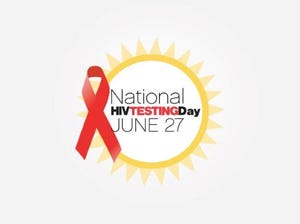Forty-one years ago this month, the U.S. Centers for Disease Control and Prevention documented for the first time a rare form of pneumonia.
The CDC noted this pneumonia was found in Los Angeles among “severely immunosuppressed” patients whose inability to fight off this or other infections was considered “unusual.”
That’s because all of the patients were young men with no previous indication of being unhealthy. Besides that, however, they shared something else: all were gay. As we now know, the CDC at the time was chronicling the dawn of America’s HIV/AIDS outbreak.
Tomorrow, June 27, is National HIV Testing Day, which provides an opportunity to recall this segment of medical history, and where Marion County is now with this particular virus.

At its outset, HIV/AIDS was both mysterious and frightening. Thus, the federal government quickly made it a top priority. Within four years of its discovery, the government pumped $190 million — or $511 million in today’s dollars — for AIDS research, even as many wanted to dismiss the illness as the exclusive province of gay men.
Yet it was clear in those early years that was not true.
In 1983, less than two years after that initial CDC report, the agency had documented cases among women who had sex with AIDS-positive men. A year later the government was warning against needle-sharing among intravenous drug users of all types. An Indiana teenager named Ryan White was denied admission to middle school in August 1985 after he contracted AIDS through a blood transfusion.
Then came the watershed moment in November 1991.
That was when NBA legend Magic Johnson announced his immediate retirement from pro basketball in the prime of his career after testing positive for HIV. As ESPN would recall a decade later, Johnson went public in the months after his diagnosis about having been with “harems of women” because he believed “heterosexuals needed to know that they, too, were at risk.”
The stigma of HIV/AIDS is far from gone, but a combination of education and medication over the past 30 years has helped reduce it. Compared to those early years, many more of us outside the scientific community understand HIV can affect anyone, but also that it can be treated and contained.
After all, the CDC reported in 2019 that 23% of all new HIV cases were derived from heterosexual contact.
In Marion County, according to Department of Health data, the death rate from HIV/AIDS dropped 52% between 2001 and 2020. The rate of AIDS diagnoses has plunged 83% over that same time, while the rate of new HIV cases has fallen 68%.
And for more good news, all three of those trends are below the rates for the entire state.
But where Marion County comes up short is testing.
On the plus side, Marion County has witnessed sharp increases in the number of adults under 65 who either have been tested within the past year or who have recorded their first-ever HIV test.
Yet our community is still 21% below the state rate when considering those recently tested, and 9% behind among those who’ve had an HIV test at any point.
This is troubling when considering the CDC estimates that up to 13% of the estimated 1.2 million Americans who live with HIV are unaware that they have the virus and need to be tested.

Tomorrow, National HIV Testing Day, is an ideal time to learn your status, your risk and what you should do if you happen to test positive. The Department of Health in Marion County will host free events for HIV/AIDS education and outreach. That includes distributing free HIV tests so people can learn their status at home.
An event is scheduled for 1–7 p.m. at Paddock Mall, 3100 SW College Rd. (State Road 200) in Ocala. Our team will offer free rapid testing with results available in 15 minutes.
As we say at the department, overcoming ignorance is the first step to preventing HIV. The life you save may not be just your own.
Anne Gerard is the senior community health nurse supervisor over the human services clinic for the Florida Department of Health in Marion County.








